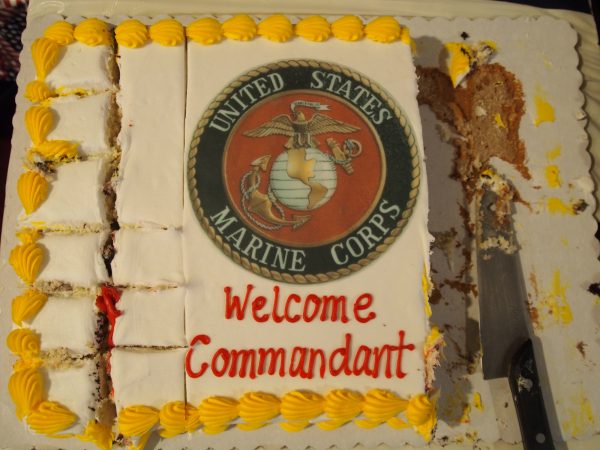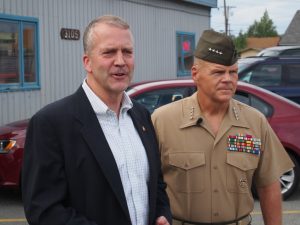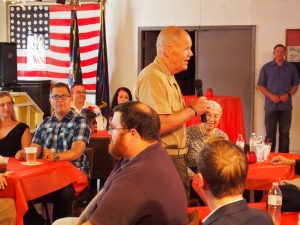
The head of the U.S. Marine Corps stopped in Anchorage and the interior this weekend to evaluate new opportunities for training. But some see it as a potential first step in building a permanent presence.
Wearing scuffed combat boots in the parking lot just outside the Mountain View VFW hall in Anchorage, Republican Senator Dan Sullivan sounded delighted as he introduced the country’s top marine.

“It’s my distinct honor as a marine myself to have the commandant of the marine corps in Alaska,” Sullivan said during brief remarks to the press.
“One of the things we’ve been trying to do is get our leadership — our military leadership — up to Alaska to see this great state, all this training that we have,” he added.
Since taking office, Sullivan has made a priority of advocating for a strong military presence in Alaska. But so far that’s been largely speaking up about the state’s main branches, the Army and Air Force. In fact, one rarely hears anything at all about marines in the 49th state.
But that may change.
The trip is General Robert Neller’s first visit to Alaska. And he says the reason is primarily to see with his own eyes the facilities available.
“We’re always looking for places to train,” Neller told reporters, adding that the marines are working with new weapons systems like the F-35 fighter jets that have expanded capabilities. “The air space up here and the instrumental ranges up here provide great opportunities.”
Though Alaska doesn’t have a significant force of active duty marines, the status of USMC units stationed in the Pacific is changing, with several thousand service-members and dependents shifting off a base in Okinawa, Japan over the next few years. And after fifteen years of wars in the Middle East, Neller said, the branch is beginning to re-build it’s capabilities to operate in colder climates.
However, Neller said there are no current plans to permanently base a sizable contingent of marines in Alaska.
After taking a few questions, Neller and Sullivan headed in to the VFW hall, which was filled with the full spectrum of military boosters, from older vets in suits seated next to their wives, all the way to young guys in motorcycle vests and bandannas.

“Just look at this place tonight. It’s packed,” Sullivan said before the audience. “Standing room only.”
Neller wandered between tables as he spoke to the crowd, giving a general update on the Marine Corps itself before dipping into his impression of Alaska so far, which he plans to take back to the Joint Chiefs of Staff in Washington, DC.
“The environment, the climate, the space–particularly air space in Alaska, is very, very interesting to me as far as opportunities for us to train Marine Air-Ground Task Forces,” Neller said.
Part of the reason for a high level commander to take two hours engaging a crowd in this way is to get a sense of how members of the community feel toward the military. Sullivan hammered home that Alaska and its veteran community are the kind of place that greets service-members and their families with open arms.
“We sell Alaska,” the senator said several times.
Standing near a vending machine, two tough-looking guys in biker vests agreed with that overall assessment.
Tom Roar is in the Air Force, and a member of the Combat Vets Motorcycle Association. As people throughout the room lined up for food and photos with the commandant, Roar explained he thinks this kind of event helps to show off Alaska to senior officials scoping it out.
“(It) tends to be pretty laid back,” Roar said of military and veteran community around Anchorage. “We get real formal when we have to and everyone’ll be up in uniform, but I think this is fabulous. You get all the old veterans out here that can come out and it’s just a relaxed atmosphere.”

Next to Roar was Todd Boren, who retired from the Air Force after 21 years, and describes the community in Alaska as one big tent.
“We poke at each other and give each other a hard time, but we’re all on the same team,” Boren said.
Not everyone at the event is convinced the commandant’s interest is just in occasional training exercises. Some see an opportunity for Alaska’s military bases to pull in a new tenant.
John E. Beasley was 19-years-old when his marine unit was caught up in the Battle of Chosin Reservoir, one of the decisive conflicts in the Korean War. He keeps a close eye on military affairs in Alaska, and thinks even if firm plans aren’t in place right now, there’s the potential for a significant number of marines to eventually be brought here.
“The Commandant doesn’t travel places just for drill,” Beasley said. He cautions that his read on the situation is “based on scuttlebutt,” but believes there’s import to Neller’s rare visit.
“I think he’s taking a look at us from the standpoint of establishing a marine contingent up here,” Beasley explained. “Again, that man doesn’t go places without a reason.”
This is first time Beasley knows of a marine commandant visiting Alaska since he moved to the state in 1968.
Zachariah Hughes reports on city & state politics, arts & culture, drugs, and military affairs in Anchorage and South Central Alaska.
@ZachHughesAK About Zachariah




